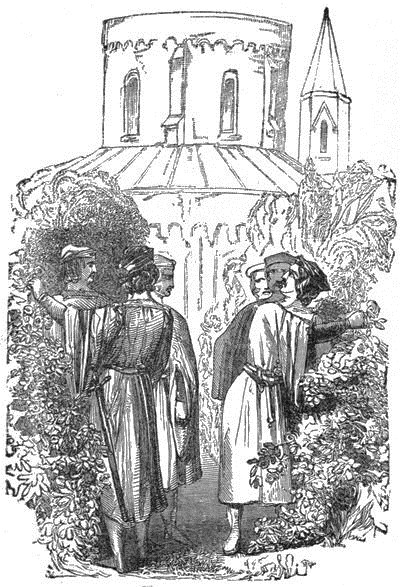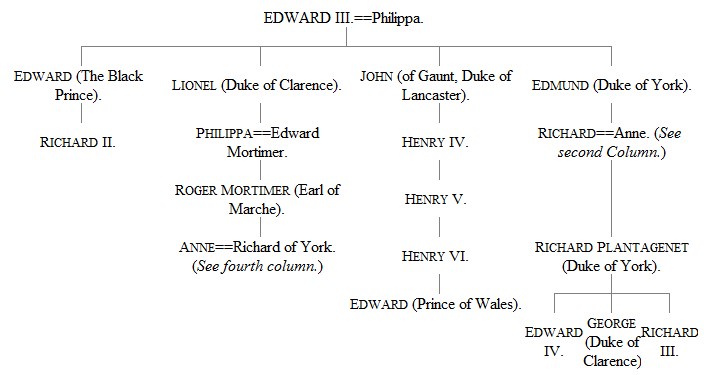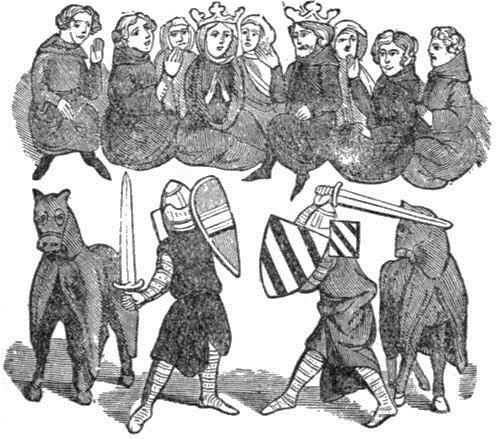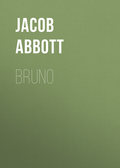
Abbott Jacob
Margaret of Anjou

The Bridal Procession.
PREFACE
The story of Margaret of Anjou forms a part of the history of England, for the lady, though of Continental origin, was the queen of one of the English kings, and England was the scene of her most remarkable adventures and exploits. She lived in very stormy times, and led a very stormy life; and her history, besides the interest which it excites from the extraordinary personal and political vicissitudes which it records, is also useful in throwing a great deal of light upon the ideas of right and wrong, and of good and evil, and upon the manners and customs, both of peace and war, which prevailed in England during the age of chivalry.

Map, Illustrating the History of Margaret of Anjou.
CHAPTER I.
The Houses of York and Lancaster
A real heroine.
Margaret of Anjou was a heroine; not a heroine of romance and fiction, but of stern and terrible reality. Her life was a series of military exploits, attended with dangers, privations, sufferings, and wonderful vicissitudes of fortune, scarcely to be paralleled in the whole history of mankind.
Two great quarrels.
She was born and lived in a period during which there prevailed in the western part of Europe two great and dreadful quarrels, which lasted for more than a hundred years, and which kept France and England, and all the countries contiguous to them, in a state of continual commotion during all that time.
Contest between the houses of York and Lancaster.
The first of these quarrels grew out of a dispute which arose among the various branches of the royal family of England in respect to the succession to the crown. The two principal branches of the family were the descendants respectively of the Dukes of York and Lancaster, and the wars which they waged against each other are called in history the wars of the houses of York and Lancaster. These wars continued for several successive generations, and Margaret of Anjou was the queen of one of the most prominent representatives of the Lancaster line. Thus she became most intimately involved in the quarrel.
Wars in France.
The second great contention which prevailed during this period consisted of the wars waged between France and England for the possession of the territory which now forms the northern portion of France. A large portion of that territory, during the reigns that immediately preceded the time of Margaret of Anjou, had belonged to England. But the kings of France were continually attempting to regain possession of it—the English, of course, all the time making desperate resistance. Thus, for a hundred years, including the time while Margaret lived, England was involved in a double set of wars—the one internal, being waged by one branch of the royal family against the other for the possession of the throne, and the other external, being waged against France and other Continental powers for the possession of the towns and castles, and the country dependent upon them, which lay along the southern shore of the English Channel.
Origin of Difficulty.
In order that the story of Margaret of Anjou may be properly understood, it will be necessary first to give some explanations in respect to the nature of these two quarrels, and to the progress which had been made in them up to the time when Margaret came upon the stage. We shall begin with the internal or civil wars which were waged between the families of York and Lancaster. Some account of the origin and nature of this difficulty is given in our history of Richard III., but it is necessary to allude to it again here, and to state some additional particulars in respect to it, on account of the very important part which Margaret of Anjou performed in the quarrel.
The difficulty originated among the children and descendants of King Edward III. He reigned in the early part of the fourteenth century. He occupied the throne a long time, and his reign was considered very prosperous and glorious. The prosperity and glory of it consisted, in a great measure, in the success of the wars which he waged in France, and in the towns, and castles, and districts of country which he conquered there, and annexed to the English domain.
The sons of Edward III.
In these wars old King Edward was assisted very much by the princes his sons, who were very warlike young men, and who were engaged from time to time in many victorious campaigns on the Continent. They began this career when they were very young, and they continued it through all the years of their manhood and middle life, for their father lived to an advanced age.
The Black Prince.
The most remarkable of these warlike princes were Edward and John. Edward was the oldest son, and John the third in order of age of those who arrived at maturity. The name of the second was Lionel. Edward, the oldest son, was of course the Prince of Wales; but, to distinguish him from other Princes of Wales that preceded and followed him, he is known commonly in history by the name of the Black Prince. He received this name originally on account of something about his armor which was black, and which marked his appearance among the other knights on the field of battle.
Richard II.
The Black Prince did not live to succeed his father and inherit the throne, for he lost his health in his campaigns on the Continent, and came home to England, and died a few years before his father died. His son, whose name was Richard, was his heir, and when at length old King Edward died, this young Richard succeeded to the crown, under the title of King Richard II. In the history of Richard II., in this series, a full account of the life of his father, the Black Prince, is given, and of the various remarkable adventures that he met with in his Continental campaigns.
John of Gaunt.
Prince John, the third of the sons of old King Edward, is commonly known in history as John of Gaunt. This word Gaunt was the nearest approach that the English people could make in those days to the pronunciation of the word Ghent, the name of the town where John was born. For King Edward, in the early part of his life, was accustomed to take all his family with him in his Continental campaigns, and so his several children were born in different places, one in one city and another in another, and many of them received names from the places where they happened to be born.

Selecting the Roses.
On the following page we have a genealogical table of the family of Edward III. At the head of it we have the names of Edward III. and Philippa his wife. In a line below are the names of those four of his sons whose descendants figure in English history. It was among the descendants of these sons that the celebrated wars between the houses of York and Lancaster, called the wars of the roses, arose.
Genealogical Table of the Family of Edward III., Showing the Connection of the Houses of York and Lancaster
Genealogical table of the descendants of Edward III

The character == denotes marriage; the short perpendicular line | a descent. There were many other children and descendants in the different branches of the family besides those whose names are inserted in the table. The table includes only those essential to an understanding of the history.
The roses.
These wars were called the wars of the roses from the circumstance that the white and the red rose happened in some way to be chosen as the badges of the two parties—the white rose being that of the house of York, and the red that of the house of Lancaster.
The four brothers.
The reader will observe that the dukes of Lancaster and York are the third and fourth of the brothers enumerated in the table, whereas it might have been supposed that any contest which should have arisen in respect to the crown would have taken place between families of the first and second. But the first and second sons and their descendants were soon set aside, as it were, from the competition, in the following manner.
Ambition of Richard's uncles. Richard's character.
The line of the first brother soon became extinct. Edward himself, the Prince of Wales, died during his father's lifetime, leaving his son Richard as his heir. Then, when the old king died, Richard succeeded him. As he was the oldest living son of the oldest son, his claim could not be disputed, and so his uncles acquiesced in it. They wished very much, it is true, to govern the realm, but they contented themselves with ruling in Richard's name until he became of age, and then Richard took the government into his own hands. The country was tolerably well satisfied under his dominion for some years, but at length Richard became dissipated and vicious, and he domineered over the people of England in so haughty a manner, and oppressed them so severely by the taxes and other exactions which he laid upon them, that a very general discontent prevailed at last against him and against his government. This discontent would have given either of his uncles a great advantage in any design which they might have formed to take away the crown from him. As it was, it greatly increased their power and influence in the land, and diminished, in a corresponding degree, that of the king. The uncles appear to have been contented with this share of power and influence, which seemed naturally to fall into their hands, and did not attempt any open rebellion.
His cousin Henry.
Richard had a cousin, however, a young man of just about his own age, who was driven at last, by a peculiar train of circumstances, to rise against him. This cousin was the son of his uncle John. His name was Henry Bolingbroke. He appears in the genealogical table as Henry IV., that having been his title subsequently as King of England.
Quarrel between Henry and Norfolk. The trial.
This cousin Henry became involved in a quarrel with a certain nobleman named Norfolk. Indeed, the nobles of those days were continually getting engaged in feuds and quarrels, which they fought out with the greatest recklessness, sometimes by regular battles between armies of retainers, and sometimes by single combat, in which the parties to the dispute were supposed to appeal to Almighty God, who they believed, or professed to believe, would give the victory to the just side in the quarrel. These single combats were arranged with great ceremony and parade, and were performed in a very public and solemn manner; being, in fact, a recognized and established part of the system of public law as administered in those days. In the next chapter, when speaking more particularly of the manners and customs of the times, I shall give an account in full of one of these duels. I have only to say here that Richard, on hearing of the quarrel between his cousin Henry and Norfolk, decreed that they should settle it by single combat, and preparations were accordingly made for the trial, and the parties appeared, armed and equipped for the fight, in the presence of an immense concourse of people assembled to witness the spectacle. The king himself was to preside on the occasion.
Henry is sent into banishment.
But just before the signal was to be given for the combat to begin, the king interrupted the proceedings, and declared that he would decide the question himself. He pronounced both the combatants guilty, and issued a decree of banishment against both. Henry submitted, and both prepared to leave the country. These transactions, of course, attracted great attention throughout England, and they operated to bring Henry forward in a very conspicuous manner before the people of the realm. He was in the direct line of succession to the crown, and he was, moreover, a prince of great wealth, and of immense personal influence, and so, just in proportion as Richard himself was disliked, Henry would naturally become an object of popular sympathy and regard. When he set out on his journey toward the southern coast, in order to leave the country in pursuance of his sentence, the people flocked along the waysides, and assembled in the towns where he passed, as if he were a conqueror returning from his victories instead of a condemned criminal going into banishment.
1400. His estates confiscated.
Soon after this, the Duke of Lancaster, Henry's father, died, and then Richard, instead of allowing his cousin to succeed to the immense estates which his father left, confiscated all the property, under the pretext that Henry had forfeited it, and so converted it to his own use. This last outrage aroused Henry to such a pitch of indignation that he resolved to invade England, depose Richard, and claim the crown for himself.
A revolution.
This plan was carried into effect. Henry raised an armament, crossed the Channel, and landed in England. The people took sides. A great majority sided with Henry. A full account of this insurrection and invasion is given in our history of Richard II. All that it is necessary to say here is that the revolution was effected. Richard was deposed, and Henry obtained possession of the kingdom. It was thus that the house of Lancaster first became established on the throne.
The elder branches of the family.
But you will very naturally wonder where the representatives of the second brother in Edward the Third's family were all this time, and why, when Richard was deposed, who was the son of the first brother, they did not appear, and advance their claims in competition with Henry. The reason was because there was no male heir of that branch living in that line. You will see by referring again to the table that the only child of Lionel, the second brother, was Philippa, a girl. She had a son, it is true, Roger Mortimer, as appears by the table; but he was yet very young, and could do nothing to assert the claims of his line. Besides, Henry pretended that, together with his claims to the throne through his father, he had others more ancient and better founded still through his mother, who, as he attempted to prove, was descended from an English king who reigned before Edward III. The people of England, as they wished to have Henry for king, were very easily satisfied with his arguments, and so it was settled that he should reign. The line of this second brother, however, did not give up their claims, but reserved them, intending to rise and assert them on the very first favorable opportunity.
Henry reigned about thirteen years, and then was succeeded by his son, Henry V., as appears by the table. There was no attempt to disturb the Lancastrian line in their possession of the throne during these two reigns. The attention, both of the kings and of the people, during all this period, was almost wholly engrossed in the wars which they were waging in France. These wars were very successful. The English conquered province after province and castle after castle, until at length almost the whole country was brought under their sway.
1422. Birth and accession of Henry VI.
This state of things continued until the death of Henry V., which took place in 1422. He left for his heir a little son, named also Henry, then only about nine months old. This infant was at once invested with the royal authority as King of England and France, under the title of Henry VI., as seen by the table. It was this Henry who, when he arrived at maturity, became the husband of Margaret of Anjou, the subject of this volume. It was during his reign, too, that the first effective attempt was made to dispute the right of the house of Lancaster to the throne, and it was in the terrible contests which this attempt brought on that Margaret displayed the extraordinary military heroism for which she became so renowned. I shall relate the early history of this king, and explain the nature of the combination which was formed during his reign against the Lancastrian line, in a subsequent chapter, after first giving a brief account of such of the manners and customs of those times as are necessary to a proper understanding of the story.
CHAPTER II.
Manners and Customs of The Time
The nobles. Their mode of life.
In the days when Margaret of Anjou lived, the kings, princes, nobles, and knights who flourished in the realms of England and France, though they were, relatively to the mass of the people, far more wealthy, proud, and powerful than their successors are at the present day, still lived in many respects in a very rude and barbarous manner. They enjoyed very few of the benefits and privileges which all classes enjoy in the age in which we live. They had very few books, and very little advantage of instruction to enable them to read those that they had. There were no good roads by which they could travel comfortably from place to place, and no wheeled carriages. They lived in castles, very strongly built indeed, and very grand and picturesque sometimes in external appearance, but very illy furnished and comfortless within. The artisans were skillful in fabricating splendid caparisons for the horses, and costly suits of glittering armor for the men, and the architects could construct grand cathedrals, and ornament them with sculptures and columns which are the wonder of the present age. But in respect to all the ordinary means and appliances of daily life, even the most wealthy and powerful nobles lived in a very barbarous way.
Retainers of the nobles.
The mass of the common people were held in a state of abject submission to the will of the chieftains, very much in the condition of slaves, being compelled to toil in the cultivation of their masters' lands, or to go out as soldiers to fight in their quarrels, without receiving any compensation. The great ambition of every noble and knight was to have as many of these retainers as possible under his command. The only limit to the number which each chieftain could assemble was his power of feeding them. For in those days men could be more easily found to fight than to engage in any other employment, and there were great numbers always ready to follow any commander who was able to maintain them.
Their courts.
Each great noble lived in state in his castle, like a prince or a petty king. Those of the highest class had their privy councilors, treasurers, marshals, constables, stewards, secretaries, heralds, pursuivants, pages, guards, trumpeters—in short, all the various officers that were to be found in the court of the sovereign. To these were added whole bands of minstrels, mimics, jugglers, tumblers, rope-dancers, and buffoons. Besides these, there was always attached to each great castle a large company of priests and monks, who performed divine service according to the usages of those times, in a gorgeously-decorated chapel built for this purpose within the castle walls.
Great power of the nobles.
Thus the whole country was divided, as it were, into a vast number of separate jurisdictions, each with an earl, or a baron, or a duke at the head of it, who ruled with an almost absolute sway in every thing that related to the internal management of his province, while, however, he recognized a certain general dominion over all on the part of the king. Such being the state of the case, it is not surprising that the nobles were often powerful enough, as will appear in the course of this narrative, to band together and set up and put down kings at their pleasure.
The Earl of Warwick.
Perhaps the most powerful of all the great nobles who flourished during the time of Margaret of Anjou was the Earl of Warwick. So great was his influence in deciding between the rival claims of different pretenders to the crown, that he is known in history by the title of the King-maker. His wealth was so enormous that it was said that the body of retainers that he maintained amounted sometimes in number to thirty thousand men.
Amusements of the nobility.
The employments, and even the amusements of these great barons and nobles, were all military. They looked down with great disdain upon all the useful pursuits of art and industry, regarding them as only fit occupations for serfs and slaves. Their business was going to war, either independently against each other, or, under the command of the king, against some common enemy. When they were not engaged in any of these wars they amused themselves and the people of their courts with tournaments, and mock combats and encounters of all kinds, which they arranged in open grounds contiguous to their castles with great pomp and parade.
Courts of justice. Quarrels among the nobles.
It could not be expected that such powerful and warlike chieftains as these could be kept much under the control of law by the ordinary machinery of courts of justice. There were, of course, laws and courts of justice in those days, but they were administered chiefly upon the common people, for the repression of common crimes. The nobles, in their quarrels and contentions with each other, were accustomed to settle the questions that arose in other ways. Sometimes they did this by marshaling their troops and fighting each other in regular campaigns, during which they laid siege to castles, and ravaged villages and fields, as in times of public war. Sometimes, when the power of the king was sufficient to prevent such outbreaks as these, the parties to the quarrel were summoned to settle the dispute by single combat in the presence of the king and his court, as well as of a vast multitude of assembled spectators. These single combats were the origin of the modern custom of dueling.
Dueling.
At the present day, the settlement of disputes by a private combat between the parties to it is made a crime by the laws of the land. It is justly considered a barbarous and senseless practice. The man who provokes another to a duel and then kills him in the fight, instead of acquiring any glory by the deed, has to bear, for the rest of his life, both in his own conscience and in the opinion of mankind, the mark and stain of murder. And when, in defiance of law, and of the opinions and wishes of all good men, any two disputants who have become involved in a quarrel are rendered so desperate by their angry passions as to desire to satisfy them by this mode, they are obliged to resort to all sorts of manœuvres and stratagems to conceal the crime which they are about to commit, and to avoid the interference of their friends or of the officers of the law.

Ordeal Combat.
The ancient trial by combat. Old representation of it.
In the days, however, of the semi-savage knights and barons who flourished so luxuriantly in the times of which we are writing, the settlement of a dispute by single combat between the two parties to it was an openly recognized and perfectly legitimate mode of arbitration, and the trial of the question was conducted with forms and ceremonies even more strict and more solemn than those which governed the proceedings in regular courts of justice.
The engraving on the preceding page is a sort of rude emblematic representation of such a trial, copied from a drawing in an ancient manuscript. We see the combatants in the foreground, with the judges and spectators behind.
Henry Bolingbroke.
It was to a public and solemn combat of this kind that Richard the Second summoned his cousin Henry Bolingbroke, and his enemy, as related in the last chapter. In that instance the combat was not fought, the king having taken the case into his own hands, and condemned both the parties before the contest was begun. But in multitudes of other cases the trial was carried through to its consummation in the death of one party, and the triumph and acquittal of the other.
Arrangements made. Guards.
Very many detailed and full accounts of these combats have come down to us in the writings of the ancient chroniclers. I will here give a description of one of them, as an example of this mode of trial, which was fought in the public square in front of King Richard the Second's palace, the king himself, all the principal nobles of the court, and a great crowd of other persons being provided with seats around the area as spectators of the fight. The nobles and knights were all dressed in complete armor; and heralds, and squires, and guards were stationed in great numbers to regulate the proceedings. It was on a bright morning in June when the combat was fought, and the whole aspect of the scene was that of a grand and joyful spectacle on a gala day.
Great concourse of people.
It was estimated that more people from the surrounding country came to London on the occasion of this duel than at the time of the coronation of the king. It took place about three years after the coronation.
The parties.
The parties to the combat were John Anneslie, a knight, and Thomas Katrington, a squire. Anneslie, the knight, was the complainant and the challenger. Katrington, the squire, was the defendant. The circumstances of the case were as follows.
Nature of the quarrel. Castle lost.
Katrington, the squire, was governor of a castle in Normandy. The castle belonged to a certain English knight who afterward died, and his estate descended to Anneslie, the complainant in this quarrel. If the squire had successfully defended the castle from the French who attacked it, then it would have descended with the other property to Anneslie. But he did not. When the French came and laid siege to the castle, Katrington surrendered it, and so it was lost. He maintained that he had not a sufficient force to defend it, and that he had no alternative but to surrender. Anneslie, on the other hand, alleged that he might have defended it, and that he would have done so if he had been faithful to his trust; but that he had been bribed by the French to give it up. This Katrington denied; so Anneslie, who was very angry at the loss of the castle, challenged him to single combat to try the question.
Reason for this mode of trial.
It is plain that this was a very absurd way of attempting to ascertain whether Katrington had or had not been bribed; but, as the affair had occurred some years before, and in another country, and as, moreover, the giving and receiving of bribes are facts always very difficult to be proved by ordinary evidence, it was decided by the government of the king that this was a proper case for the trial by combat, and both parties were ordered to prepare for the fight. The day, too, was fixed, and the place—the public square opposite the king's palace—was appointed. As the time drew nigh, the whole country for many miles around was excited to the highest pitch of interest and expectation.
The company assemble. The combatants appear.
At the place where the combat was to be fought a large space was railed in by a very substantial barricade. The barricade was made very strong, so as to resist the utmost possible pressure of the crowd. Elevated seats, commanding a full view of the lists, as the area railed in was called, were erected for the use of the king and the nobles of the court, and all other necessary preparations were made. When the hour arrived on the appointed day, the king and the nobles came in great state and took their places. The whole square, with the exception of the lists and proper avenues of approach, which were kept open by the men-at-arms, had long since been filled with an immense crowd of people from the surrounding country. At length, after a brief period of expectation, the challenger, Anneslie, was seen coming along one of the approaches, mounted on a horse splendidly caparisoned, and attended by several knights and squires, his friends, all completely armed.
The horse excluded.
He stopped when he reached the railing and dismounted from his horse. It was against the laws of the combat for either party to enter the lists mounted. If a horse went within the inclosure he was forfeited by that act to a certain public officer called the high constable of England, who was responsible for the regularity and order of the proceedings.
Anneslie, having thus dismounted from his horse with the assistance of his attendants, walked into the lists all armed and equipped for the fight. His squires attended him. He walked there to and fro a few minutes, and then a herald, blowing a trumpet, summoned the accused to appear.
Summons to the accused.
"Thomas Katrington! Thomas Katrington!" he cried out in a loud voice, "come and appear, to save the action for which Sir John Anneslie, knight, hath publicly and by writing appealed thee!"
Appearance of Katrington.
Three times the herald proclaimed this summons. At the third time Katrington appeared.
He came, as Anneslie had come, mounted upon a war-horse splendidly caparisoned, and with his arms embroidered on the trappings. He was attended by his friends, the representatives of the seconds of the modern duel. The two stopped at the entrance of the lists, and dismounting, passed into the lists on foot. Every body being now intent on the combatants, the horse for the moment was let go, and, being eager to follow his master, he ran up and down along the railing, reaching his head and neck over as far as he could, and trying to get over. At length he was taken and led away; but the lord high constable said at once that he should claim him for having entered the lists.
Horse's head forfeited.
"At least," said he, "I shall claim his head and neck, and as much of him as was over the railing."
The pleadings.
The combatants now stood confronting each other within the lists. A written document was produced, which had been prepared, as was said, by consent of both parties, containing a statement of the charge made against Katrington, namely, that of treason, in having betrayed to the enemy for money a castle intrusted to his charge, and his reply. The herald read this document with a loud voice, in order that all the assembly, or as many as possible, might hear it. As soon as it was read, Katrington began to take exceptions to some passages in it. The Duke of Lancaster, who seemed to preside on the occasion, put an end to his criticisms at once, saying that he had already agreed to the paper, and that now, if he made any difficulty about it, and refused to fight, he should be adjudged guilty of the treason, and should at once be led out to execution.






